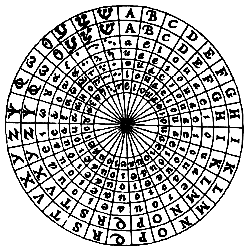

Giordano Bruno the Nolan was an excommunicated Dominican friar who had developed an art, science and philosophy which was a Hermetic interpretation of Copernicus and Lucretius. Francis A. Yates, a primary interpreter of Bruno for our age, has written of him, The lunatic, the lover, and the poet were never all of imagination so compact as in Giordano Bruno. His life and stand against the mediocrity of papal hierarchy and monastic privilege of his times is the essence of the artist/rebel/poet which we are so familiar with now.
His unbending integrity and lack of compromise resulted in him being hounded throughout Europe by the Church, and he lived a life on the road as wandering scholar, writer, and teacher. Eventually they caught up with him, placed him into prison for eight years, and ordered him to recant the heretical passages of his works. He would not cooperate or change his views. They tortured him, still he would not recant. Finally, on February 17th, 1600, he was taken out into the Campo dei Fiori in Rome, and burned alive at the stake as an unrepentant heretic.
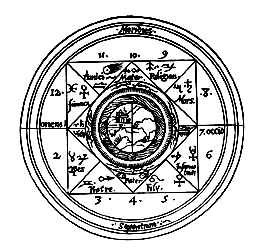 Bruno studied the
ancient myths and 'secret' lost philosophies of his time, and developed a world
view that because of its anachronisms, can often be seen as far more
contemporaneous to our own times, than the age of the new rationality in
which he lived. For example, from his readings of the apocryphal writings of
the supposed Egyptian magus, Hermes Trismegistus, Bruno advocated (along with a
metaphysical interpretation of the mathematics to support his view) the then
radical Copernican view of a heliocentric universe: a point of view which is at
the corner stone of the changes in thinking that occurred in the Renaissance
[1].
Bruno studied the
ancient myths and 'secret' lost philosophies of his time, and developed a world
view that because of its anachronisms, can often be seen as far more
contemporaneous to our own times, than the age of the new rationality in
which he lived. For example, from his readings of the apocryphal writings of
the supposed Egyptian magus, Hermes Trismegistus, Bruno advocated (along with a
metaphysical interpretation of the mathematics to support his view) the then
radical Copernican view of a heliocentric universe: a point of view which is at
the corner stone of the changes in thinking that occurred in the Renaissance
[1].
His view of the fundamental workings of language based on his studies of ancient languages, approaches that of contemporary semiotics: ...images do not receive their names from the explanations of the things they signify, but rather from the condition of those things that do the signifying [2]. A view which was repeated by Fernand de Saussure nearly 300 years later in the 1890's with his idea that a word is composed of two parts: the 'signified' and the 'signifier,' and is at the foundation of modern linguistics.
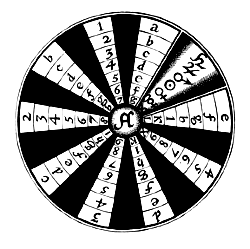 Bruno, being
a skilled Renaissance rhetorician, also devised memory systems of the utmost
complexity: In them finally are all that can be said, known, imagined; here
are all arts, languages, works, and signs [3].
Based in a rich synesthesia [4] were two opposites
eventually coincide as a single unity -- the most infinite is contained in the
most minuscule. His works on this art are detailed collections of rules based
in the principles of poetry, and describe the construction of memory images out
of a history of human observation. These images were then to be encoded within
the mind while observing the heavenly bodies and their orbits. The rotation of
the heavenly gyres as concentric memory wheels, would bring a finite set of
images into ever changing proximity and juxtapositions to one another which
would then imply and suggest imaginative connections to lost wisdom.
Bruno, being
a skilled Renaissance rhetorician, also devised memory systems of the utmost
complexity: In them finally are all that can be said, known, imagined; here
are all arts, languages, works, and signs [3].
Based in a rich synesthesia [4] were two opposites
eventually coincide as a single unity -- the most infinite is contained in the
most minuscule. His works on this art are detailed collections of rules based
in the principles of poetry, and describe the construction of memory images out
of a history of human observation. These images were then to be encoded within
the mind while observing the heavenly bodies and their orbits. The rotation of
the heavenly gyres as concentric memory wheels, would bring a finite set of
images into ever changing proximity and juxtapositions to one another which
would then imply and suggest imaginative connections to lost wisdom.
The memory-charged imagination would therefore by sympathetic analogy, exposed the observer to all the varieties of being: Being is perceived and distinguished under three headings, universally called metaphysical, physical, and logical, as these are the three principles of everything: God, nature and art; and three effects proceed from this, divine, natural, and artificial [5]. From the variety of all things a singularity emerges in the form of synesthesia: The order of the cosmos is rational, as it is in the likeness of the natural, of which it is the shadow, as it is the image of the divine, of which it is the vestige [6].
Bruno in his exile, travelled throughout Italy, France, England, and Germany. He peddled his books to rich patrons, and he personally knew many of the important thinkers of his time: people like Sir Phillip Sydney, William Shakespeare, and John Dee. His ideas were a synthesis of Western thought up to that point and were widely familiar. Even though his (as well as others) mnemonic investigations quickly became unfashionable and ignored (largely because its mediaeval practical use had been rendered archaic by print culture, it had a most profound influence by ironically turning contemporary thought towards science. The practice of this Reminiscence form of the art, by stressing systematic classification of observable material and representing it in a manipulatable symbol, was transformed into a science of nature, as empirical methods gained in popularity.
With the rise of science in the seventeenth century the use of the art of memory, eventually reverted back to the Aristotelian form. However, within the last gasps of the dying skills needed to support the dwindling manuscript culture, there is an exception in the works of the Neapolitan scholar and rhetorician, Giambattista Vico. He was a pivotal figure in revising the role of memory in modern cultural as being the basis of a New Science of history.
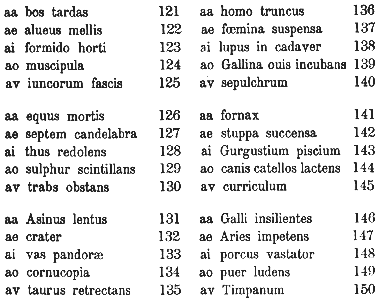
'Memory Wheel' and excerpt of a memory correspondence chart from Bruno's De Umbris Idearum (1582).
References and Notes:
1. A new translation of a Bruno work
with a long introduction explaining his cosmological significance to the
science of modern astronomy is available as Giordano Bruno, The Ash
Wednesday Supper, edited and translated by Edward A. Gosselin and Lawrence
S. Lerner (Toronto: University of Toronto Press, 1995 [1977]).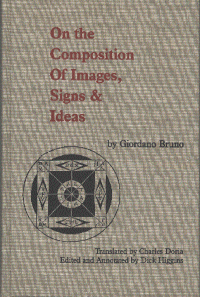
2. Giordano Bruno, On the Composition of Images, Signs & Ideas, translated by Charles Doria, edited and annotated by Dick Higgins (New York: Willis, Locker & Owens, 1991), p. 31. This detail of Bruno's work is taken from the introduction to this translation (pp, xxxvi-xxxvii). That one of the original members of FLUXUS is an editor for this book, indicates in no small degree, the contemporary appeal of Bruno's ideas.
3. ibid, p. 5.
4. ibid, from the introduction, xxxviii: ...Bruno argues for the unity of all the arts in a way that suggests Nineteenth Century ideas about synesthesia or Twentieth Century ones about intermedia. And, civil: His synesthesia, which sometimes becomes an aesthetic, the convergence of poetry, prose and visual art, is of interest today also, and it is noteworthy that Bruno provides a historic paradigm for this. See also, Kurt Schwitters.
5. ibid, p. 7.
6. ibid, p. 9.